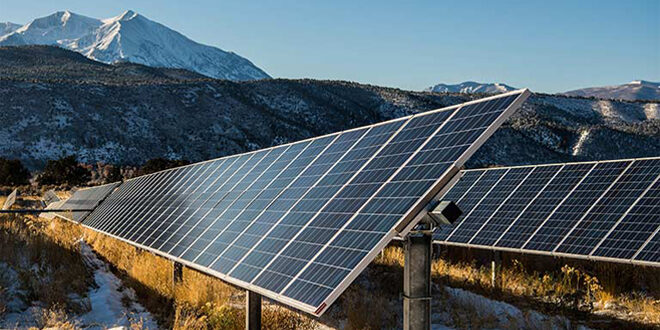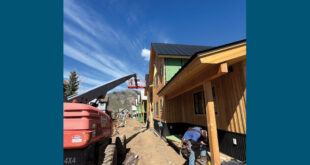Starting with incentives; requirements may come later
By Katherine Nettles
Gunnison County policy makers are looking at how to approach another set of building code updates, this time related to energy. The latest effort, which is required by the state of Colorado in the next few years, comes on the heels of the county’s transition to new building codes related to reducing wildfire hazard. After an initial discussion last week, Gunnison County commissioners directed staff to draft a gradual energy code transition beginning with added incentives before establishing new requirements over time.
In 2022, the state of Colorado passed a bill requiring that all jurisdictions adopt the 2021 International Energy Conservation Code (IECC) by July 2026. The town of Crested Butte and city of Gunnison have already adopted the 2021 IECC and Gunnison County expects to do so through a series of amendments to the current Land Use Resolution (LUR).
During their April 25 work session, commissioners and staff discussed how to transition toward the IECC requirements. Assistant county manager for community and economic development Cathie Pagano, assistant county manager for operations and sustainability John Cattles and building/environmental health official Crystal Lambert provided an overview of the county’s strategic plan related to climate change, as well as IECC standards and energy efficiency ratings and some specific staff recommendations related to both.
Overall strategy
The county’s strategic plan includes reducing energy use impacts and lowering greenhouse gas emissions by 50% from 2005 levels by 2030. Staff presented three options to help achieve these goals and asked for commissioner input on each.
The first option is to incentivize people applying for permits to use the 2021 IECC Energy Rating Index (ERI), which is a tool used to represent the energy performance of a home. Applicants that choose this path would receive a reduced plan review fee in the county building process from 30% of the building permit fee to 22.5%.
Applicants that choose this path might also be prioritized for review.
The second option is to require use of the ERI approach for new residences greater than 5,000 square feet. “This option could help normalize the use of energy ratings for new home construction in our area. Additionally, staff time to review and inspect larger homes for energy code compliance is time consuming as these structures tend to have multiple and complicated assembly types,” according to the accompanying staff memo.
The third and most aggressive option is to create an energy budget allowance for all new homes based on a model home of ideal energy use and require that new construction comply with such a model.
“The prohibition of energy consumption beyond a certain amount would effectively limit size and many luxury amenities that may be included in new residential structures such as pools, heated driveways, outside heating devices, or numerous appliances, unless other energy saving features are incorporated sufficient to maintain overall energy use at or below the energy budget,” according to the memo. “If the energy budget was set based [on] the median home size and code minimum energy performance compliance then there would be essentially no impact on the median home.”
In discussion of these options, county commissioner chair Jonathan Houck asked if personnel is in place to manage additional requirements. “If we are going to ask people to do something, we have to make sure that the resources in the community or at least adjacent to the community are available and at a rate that’s not the barrier to implementation,” he said.
Cattles said a lot of this can be streamlined by the project designers and through available resources online and at the state level. He also addressed affordability.
“We have some of the most energy burdened households in the state. What we don’t have is the reaction. There is sort of a disconnect there, and we don’t know what it is,” said Cattles. He speculated that sometimes cost may be the barrier, but even on new builds energy efficiency still doesn’t seem to rise in priorities.
“I think it’s just part of the norms,” said Pagano, referencing national patterns and contractor habits.
Cattles said as energy costs rise, more and more people are looking for assistance and becoming more interested in energy efficiency.
County commissioner Liz Smith commented that, overall, the 2021 IECC seems like an opportunity for people to choose more efficient energy sources and the level of their own carbon impacts. “And this will build toward a future in which people have options financially and energy-wise,” she said.
While recognizing that many of the recommendations would be controversial among home builders, only the seventh recommendation regarding model homes proved contentious among commissioners.
Houck said he liked the model home concept but expressed his concern about staff time and capacity to produce it given all the other projects county staff are currently working on. County manager Matthew Birnie added that, with property prices so high in the North Valley, most buyers who can afford property want a custom-designed home.
Pagano countered that she expects the cost of developing such a model would be $30,000 to $50,000 if the county uses a third party to create the model. Pagano expressed that it would be relevant to property owners in concentrated areas such as north of Gunnison, Crested Butte South and Buckhorn, among others.
“From my perspective, it’s an important incentive to offer. We’re offering a free set of plans to anyone across a variety of home types…and then they are making an energy efficient rated choice. I think that savings is huge—far more than 7% off your home building fee.”
Commissioner Laura Puckett Daniels supported the idea. “We have very few ways to bring down the cost of housing in this county, and this is a way to do it at relatively low cost to us.”
“That’s why we came to you with these options, because you can’t solve affordable housing with just one tool, one policy, one initiative,” said Pagano, addressing concerns of how energy codes in general would also raise costs.
Commissioners ultimately agreed and discussed pushing the model home plans idea to 2024, which Cattles said was its likely timing anyway.
A phased approach
Commissioners asked for a phased approach to adopting the 2021 EICC and related changes, using incentives now and gradually moving to requirements.
“I’m thinking about this very long term,” said Puckett Daniels, mapping out three phases. “Phase one, we incentivize with prescriptive options. And I would like to see [energy rating] requirements for homes over 5,000 square feet.
“Then in phase two, we introduce the energy budget for larger homes, and then phase three we start to require energy ratings for smaller homes.” She requested a program providing energy rating services for folks in lower incomes, similar to other local programs and suggested leveraging funds through the state.
Smith agreed with that approach, emphasizing the importance of establishing energy rating methods before creating an energy budget. Houck agreed with the same general direction.
Staff will finalize the direction given by the commissioners, then present the recommendations to the Gunnison County Planning Commission for further analysis and provide a final recommendation to the commissioners. The planning commission and commissioners will also hold public meetings as part of their evaluation process.
 The Crested Butte News Serving the Gunnison Valley since 1999
The Crested Butte News Serving the Gunnison Valley since 1999


